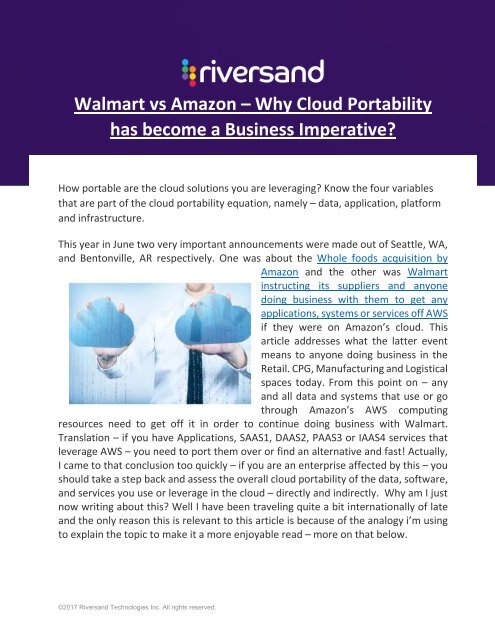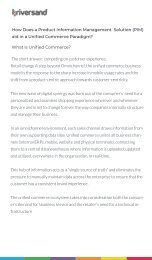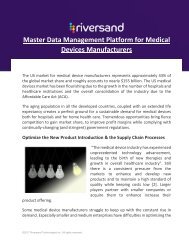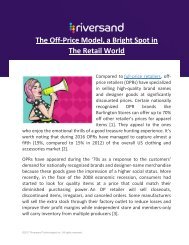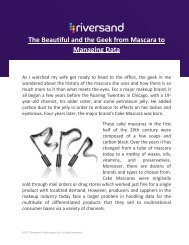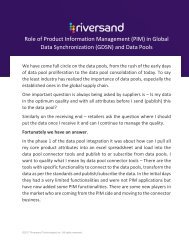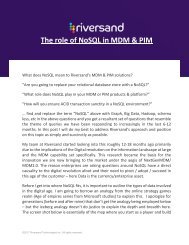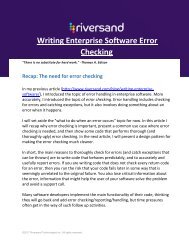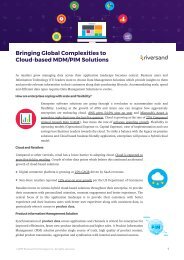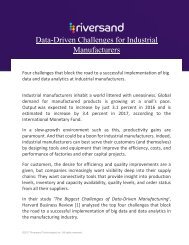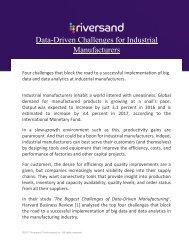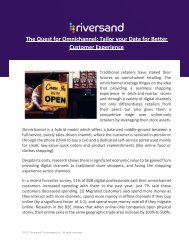Walmart vs Amazon – Why Cloud Portability has become a Business Imperative
You also want an ePaper? Increase the reach of your titles
YUMPU automatically turns print PDFs into web optimized ePapers that Google loves.
<strong>Walmart</strong> <strong>vs</strong> <strong>Amazon</strong> <strong>–</strong> <strong>Why</strong> <strong>Cloud</strong> <strong>Portability</strong><br />
<strong>has</strong> <strong>become</strong> a <strong>Business</strong> <strong>Imperative</strong>?<br />
How portable are the cloud solutions you are leveraging? Know the four variables<br />
that are part of the cloud portability equation, namely <strong>–</strong> data, application, platform<br />
and infrastructure.<br />
This year in June two very important announcements were made out of Seattle, WA,<br />
and Bentonville, AR respectively. One was about the Whole foods acquisition by<br />
<strong>Amazon</strong> and the other was <strong>Walmart</strong><br />
instructing its suppliers and anyone<br />
doing business with them to get any<br />
applications, systems or services off AWS<br />
if they were on <strong>Amazon</strong>’s cloud. This<br />
article addresses what the latter event<br />
means to anyone doing business in the<br />
Retail. CPG, Manufacturing and Logistical<br />
spaces today. From this point on <strong>–</strong> any<br />
and all data and systems that use or go<br />
through <strong>Amazon</strong>’s AWS computing<br />
resources need to get off it in order to continue doing business with <strong>Walmart</strong>.<br />
Translation <strong>–</strong> if you have Applications, SAAS1, DAAS2, PAAS3 or IAAS4 services that<br />
leverage AWS <strong>–</strong> you need to port them over or find an alternative and fast! Actually,<br />
I came to that conclusion too quickly <strong>–</strong> if you are an enterprise affected by this <strong>–</strong> you<br />
should take a step back and assess the overall cloud portability of the data, software,<br />
and services you use or leverage in the cloud <strong>–</strong> directly and indirectly. <strong>Why</strong> am I just<br />
now writing about this? Well I have been traveling quite a bit internationally of late<br />
and the only reason this is relevant to this article is because of the analogy i’m using<br />
to explain the topic to make it a more enjoyable read <strong>–</strong> more on that below.<br />
©2017 Riversand Technologies Inc. All rights reserved.
At this point you are probably wondering the following:<br />
1. Is this a hoax?<br />
2. If not, is my business/company impacted?<br />
3. If so how? And what questions (let alone answers) do I need to be asking?<br />
Before we go there <strong>–</strong> let’s take a minute to understand what cloud portability means.<br />
Here is what Webopedia defines it as -” … the ability to move applications and its<br />
associated data between one <strong>Cloud</strong> provider to another with minimal disruption<br />
and/or downtime”. If that didn’t do it for you OAGIS <strong>has</strong> an awesome paper worth<br />
reading <strong>–</strong> albeit a very heavy technical read. I have found that for my “User”<br />
constituents (yes it’s a Tron reference) neither the high level nor too low/detailed<br />
level of information on this subject helps. My attempt here is to make this more<br />
straightforward so that you can take appropriate action.<br />
Four variables of <strong>Cloud</strong> <strong>Portability</strong><br />
There are 4 main variables that are part of the cloud portability equation, namely <strong>–</strong><br />
data, application, platform and infrastructure. Data is either stuff you generate<br />
(supply) or consume (demand) depending on your role as the trading partner.<br />
©2017 Riversand Technologies Inc. All rights reserved.
Applications are code components that perform Create/Read/Update/Delete<br />
functions on the Data. Depending on how your applications are built you could either<br />
have platforms that contain and manage the application which sit on a cloud<br />
provider’s infrastructure or the infrastructure and platform are one and the same<br />
(also called Bare-metal).<br />
If the cloud application is designed and built leveraging (and tied to) a specific cloud<br />
provider’s (in this case AWS’) platform and/or infrastructure capabilities <strong>–</strong> then the<br />
amount of rework involved at all layers goes up when it comes time to migrate or<br />
port-from one provider to another. The same scenario also applies depending on<br />
what persistence stores are used for storing the data.<br />
This brings me back to my traveling and my analogy. When you travel internationally,<br />
you know you have to account for power adapters to charge and power your<br />
electronic devices (120v-220v and various wattage requirements) and various<br />
region/country/continent specific plug/pin types). Designing, building & maintaining<br />
for cloud interoperability is like the Swiss Army knife of power chargers <strong>–</strong> you need<br />
one with the most options <strong>–</strong> so you can work with your devices (application) in<br />
different countries or regions. The cloud providers, like the country-specific power<br />
regulations, are only making things more complex. Ensuring you are adopting cloudbased<br />
solutions with portability and interoperability baked-in by design is the only<br />
way to ensure your business can adapt to the changing business conditions as they<br />
arise.<br />
How portable are the cloud solutions you are leveraging? Hopefully, now you know<br />
how to peel that onion and be more action oriented on this topic. As a data<br />
management company, Riversand <strong>has</strong> invested heavily in making our next generation<br />
MDM & PIM platform multi-cloud portable by design to ensure that porting between<br />
cloud providers is as seamless as possible. This helps our customers adapt to not only<br />
the current situation with <strong>Walmart</strong> (and Target) <strong>vs</strong> <strong>Amazon</strong> but also with countryspecific<br />
regulations around privacy, GDPR in Europe and beyond. Come see for<br />
yourself at www.riversand.com<br />
Watch Webinar: Best Practices of Digital Innovation for PIM and<br />
MDM in <strong>Cloud</strong><br />
©2017 Riversand Technologies Inc. All rights reserved.
Riversand is an innovative leader in Master Data Management, powering industries from the<br />
world's largest to SMBs. Riversand's single integrated, scalable and robust multi-domain MDM<br />
platform caters to a variety of use cases across multiple verticals. In addition Riversand offers<br />
specific solutions such as Vendor Portal, Spare Parts Management, Material Master, GDSN onboarding,<br />
Media Assets Management, Print Publishing etc. <strong>Business</strong> value which Riversand<br />
provides include accelerated time-to-market, increased sales, improved order accuracy, reduced<br />
costs and enhanced customer service. Customer satisfaction is at the heart of Riversand's<br />
innovation.<br />
For more information, visit Riversand.com and follow @RiversandMDM on Twitter.<br />
LEARN MORE<br />
©2017 Riversand Technologies Inc. All rights reserved.


